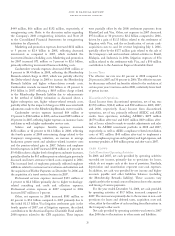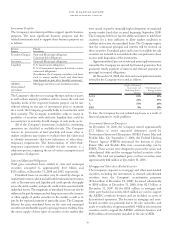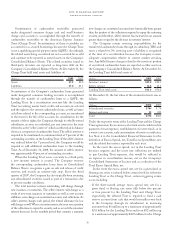American Express 2008 Annual Report Download - page 31
Download and view the complete annual report
Please find page 31 of the 2008 American Express annual report below. You can navigate through the pages in the report by either clicking on the pages listed below, or by using the keyword search tool below to find specific information within the annual report.2008 financial review
american express company
Cash Flows from Investing Activities
The Company’s investing activities primarily include
funding cardmember loans and receivables, securitizations
of cardmember loans and receivables, and the Company’s
available-for-sale investment portfolio.
For the year ended December 31, 2008, net cash provided
by investing activities of $7.0 billion increased compared to
2007, primarily due to net decreases in cardmember receivables
and loans balances and cash provided by the sale of investments
attributable to discontinued operations offset by cash used for
acquisitions.
In 2007, net cash used in investing activities increased from
2006 primarily as a result of an increase in cardmember loans
and receivables.
Cash Flows from Financing Activities
The Company’s financing activities primarily include issuing
and repaying debt, taking customer deposits, paying dividends,
and repurchasing its common shares.
In 2008, net cash used in financing activities of $10.4 billion
increased compared to 2007, primarily due to net repayments
of debt and the net cash used in financing activities attributable
to discontinued operations, partially offset by a decrease in the
repurchase of American Express common shares from 2007.
In 2007, financing activities provided net cash greater than in
2006 primarily due to net increases in borrowings and customer
deposits.
impact of credit and capital market
environment
Credit Markets – U.S. Consumer and Small Business Lending
During 2008, deteriorating home prices, rising unemployment
and broad tightening of consumer credit adversely affected
U.S. credit card issuers generally, including the Company.
In addition, several other factors had a significant impact on
the Company’s credit performance. First, the Company’s
cardmember base is somewhat more skewed towards the states
hardest hit by the U.S. real estate decline, such as California
and Florida. Second, the Company added new cardmembers
faster than the industry overall in the past three years, and the
credit performance of 2-3 year old vintages tends to be worse
than that of other vintages; however, this is part of the normal
seasoning process. Third, the Company has a large portfolio of
small business accounts, which typically have higher write-off
rates and delinquencies than consumers. Finally, the economic
downturn in 2008 had a significant impact on many of the
Company’s affluent cardmembers.
These factors led to a sharp deterioration of the Company’s key
lending credit metrics, with the 30+ day delinquency rate rising
from 2.8 percent in 2007 to 4.4 percent in 2008 and the write-off
rate rising from 3.5 percent in 2007 to 5.5 percent in 2008. As a
result, the Company added significantly to the USCS cardmember
lending reserves for losses in 2008.
In managing risk, the Company’s objective is to protect
its profitability, but also protect, to the extent it can, the
Company’s ongoing relationship with its cardmembers. With
this in mind, the following actions have been taken by the
Company across the U.S. Card Services portfolios:
• incorporating more sophisticated information in the Company’s
risk evaluations;
• focusing on areas of high risk, and canceling certain accounts;
• reducing some lines of credit;
• increasing the number of customer care professionals; and
• assisting cardmembers who are experiencing temporary
financial difficulty.
The Company’s view as noted above is that economic conditions
will deteriorate further in 2009. As a result, it is expected that
past due loans and write-offs will continue to rise further in the
first quarter of 2009 versus the fourth quarter of 2008 and that
the second quarter of 2009 will be higher than the first quarter
of 2009.
Capital Markets
The global money and capital markets have been experiencing
periods of liquidity disruption and rate volatility since the third
quarter of 2007. Liquidity, benchmark interest rates, and credit
concerns were further exacerbated during September 2008,
fueled by heightened concerns about the global financial system
after the collapse of several large financial institutions in the
United States and elsewhere.
The Company’s funding strategy seeks the issuance of debt
and the acceptance of deposits with a wide range of maturities
to spread out or “ladder” the refinancing requirement in future
periods. Since September 2008, the market for the Company’s
unsecured term debt and asset securitizations, like that for
virtually all financial institutions, has been effectively frozen,
except in connection with the Company’s participation in certain
programs sponsored by the federal government and certain of its
departments and agencies.
These government programs, launched or announced by the
U.S. and other governments during the fourth quarter of 2008,
provided some stability to the capital markets and reduced
dislocations in benchmark indices such as LIBOR. However, if
the unprecedented levels of volatility and disruptions reemerge
or worsen, they could negatively impact the Company’s funding
capabilities, liquidity position, and investment portfolios or
derivative positions.
29
























